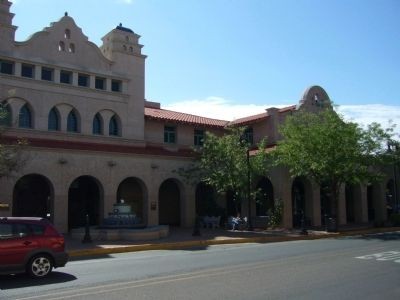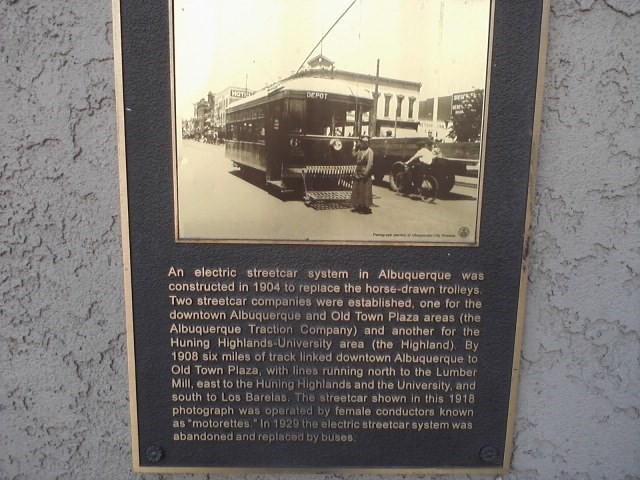Albuquerque Electric Streetcar System Historical Marker
Introduction
Text-to-speech Audio
Images
The Albuquerque Alvarado Transportation Center where the historical marker is located outside of. Photo is courtesy of Bill Kirchner

this plaque is located just past the central fountain at the entrance of the Alvarado Transportation Center.

Backstory and Context
Text-to-speech Audio
Up until 1904, trolleys in Albuquerque, New Mexico, were pulled by horses. In 1904, however, an electric streetcar system was created, and two companies were established. One company served downtown Albuquerque and the Old Town Plaza areas, and another served the Huning Highlands-University area. In only four years, six miles of tracks connected different places in Albuquerque. A motorman and a conductor ran 10 green double-ended streetcars.
While convenient for residents of Albuquerque, the electric streetcar system also meant that suburbs were beginning to grow. Albuquerque had a morning rush hour like many other cities, with businessmen and workers, but these workers no longer had to live within walking distance of their places of employment. The streetcar system meant that people could move to the suburbs and commute into the city for work every day.
By 1929, technological advancement again changed transportation in Albuquerque. Automobiles became popular in the 1920s, and buses that were powered by gas replaced streetcars at the end of the decade.
Sources
Kirchner, Bill. Albuquerque Electric Streetcar System, The Historical Marker Database. August 2nd 2011. Accessed December 27th 2019. https://www.hmdb.org/m.asp?m=45447.
Simmons, Marc. Trail Dust: Trolleys were once the rule in New Mexico cities, Santa Fe New Mexican. October 25th 2013. Accessed December 27th 2019. https://www.santafenewmexican.com/news/trail_dust/trail-dust-trolleys-were-once-the-rule-in-new-mexico/article_e8e27ef3-8e91-5ddf-99f7-df2e5427a4f3.html.
Historical Marker Database
Image from user GeoFeret at the Waymarking website
